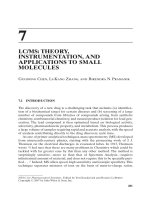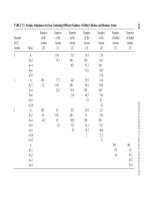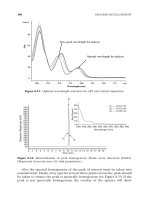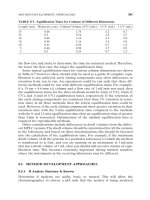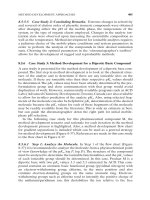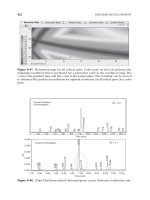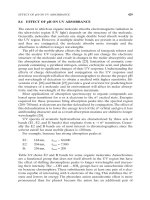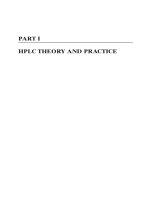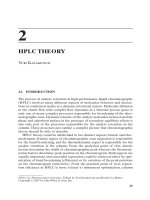Tài liệu HPLC for Pharmaceutical Scientists 2007 (Part 8A) ppt
Bạn đang xem bản rút gọn của tài liệu. Xem và tải ngay bản đầy đủ của tài liệu tại đây (282.01 KB, 21 trang )
8
METHOD DEVELOPMENT
Rosario LoBrutto
8.1 INTRODUCTION
The primary focus of this chapter in on general approaches and considerations
toward development of high-performance liquid chromatography (HPLC)
methods for separation of pharmaceutical compounds, which may be applied
within the various functions in the drug development continuum. It is very
important to understand the aim of analysis and the requirements for a par-
ticular method to be developed. The aim of analysis of each HPLC method
may vary for each developmental area in the drug development process and
specific examples are given in Section 8.2.
General method development considerations that apply to all reversed-
phase methods are discussed in Section 8.3. These include properties of the
analyte, detector, mobile phase, stationary phase, and gradient considerations.
Building upon this knowledge, strategies for method development for target
analytes in which the structure is known and not known are given as general
guidelines. This material is reinforced with several method development case
studies emphasizing the approaches used and the shortcomings that were
encountered during the method development continuum. Also, a method
development flow chart for gradient separations is provided in Section 8.5.6
(Figure 8-37) which can be used as an excellent starting point for the devel-
opment of HPLC methods.
Also, throughout this chapter we focus on analytical challenges a pharma-
ceutical scientist encounters during method development; these include speed
347
HPLC for Pharmaceutical Scientists, Edited by Yuri Kazakevich and Rosario LoBrutto
Copyright © 2007 by John Wiley & Sons, Inc.
of separation, sample preparation, extraction issues, solution stability,
detection sensitivity (effect of pH), and separations for structurally similar
species.
The final part of the chapter provides a refresher on “pK
a
from an analy-
tical chemist’s perspective,” the drivers for choosing normal phase versus
reversed phase as a separation mode for a particular analysis, and instru-
ment/system consideration, and it concludes with a very interesting section on
column testing within the framework of bonded phase stability (effect of pH
and type of buffer) and probing column selectivity.
8.2 TYPES OF METHODS
There are many HPLC methods that are developed during the process of drug
development. The chromatographer needs to understand the aim of analysis
in order to make judicious choices prior to the commencement of method
development and the implications it may have on the final method that is
developed.The following should be considered: method development time, the
maximum run time for analysis, the number of samples expected per week,
the complexity of the mixture, the structure of the main analyte (physico-
chemical properties), possible degradation pathways (i.e., hydrolysis, oxida-
tive, photolysis, dethydration, thermolytic, racemization), and whether the
analyte or analytes are ionizable.
In Section 8.2, the aim of analysis is emphasized especially for the API
(active pharmaceutical ingredient) and the drug product. The workflows and
the rationale at major decision points during synthetic processing steps where
HPLC can be applied in process development are elaborated upon. For
example, a fast method is needed to monitor reaction conversion of two
components. However, a more complex method would be needed for stabil-
ity-indicating purposes where multiple degradation products, synthetic
by-products, and excipient peaks need to be resolved from the active phar-
maceutical ingredient.
8.2.1 Key Raw Materials
The purity of the starting materials needs to be determined in order to ensure
the purity of the final compound and to avoid any undesired secondary reac-
tions that may carry forward in the downstream chemistry. Starting materials
can be classified as raw materials or key raw materials. The latter are raw mate-
rials in which some part of the raw material structure is incorporated into the
final structure of the drug substance. For the raw materials, usually an identi-
fication test and concentration of the reagent suffices although the purity of
these materials is sometimes also deemed as a necessity. However, for key raw
materials the purity of this reagent must be known. The analysis of the key
raw materials depends on the nature of the substance (i.e., volatility) and a
348 METHOD DEVELOPMENT
variety of methods could be used such as GC and HPLC.To ensure the quality
of the key raw materials, the level and type of impurities present in these mate-
rials need to be determined and appropriate specifications need to be set.
These can be determined by running a small-scale synthesis (i.e., front run)
with the key raw material; and if an intermediate with an acceptable purity is
obtained in the next step of the synthesis, the level and type of impurities
present in the key raw materials can be considered acceptable. Note that the
impurities may carry forward in the downstream chemistry and/or may react
to form new synthetic by-products. If these synthetic by-products are carried
forward to the final API, these impurities must be qualified in the appropri-
ate toxicological studies if they are above a certain level (also, any potential
genetoxic impurities must be identified and well-controlled with sensitive ana-
lytical methods). Different lots from the same manufacturer and/or lots of key
raw materials from different manufacturers are usually tested.
In the following example, the importance of determining the quality of the
key raw material is highlighted. Trimethoprim (TMP) (2-4-diamino-5-(3,4,5-
trimethoxybenzyl)pyrimidine) is an antibacterial, folic acid antagonist that is
usually used with sulfamethoxazole as a treatment for urinary tract infections.
Shown in Figure 8-1 is one synthetic scheme of TMP [1]. The starting mater-
ial that is used is 3,4,5-trimethoxy benzaldehyde (a key raw material). Depend-
ing on the quality of this key raw material, the impurities from this starting
material may further react in the subsequent synthetic steps (downstream
chemistry) at the benzaldehyde functionality to produce undesired synthetic
by-products. TMP manufactured by five different manufacturers from three
countries of origin were analyzed by the same HPLC chromatographic
method; two impurities, Impurity 1 and Impurity 2, were found in multiple lots
of TMP, and the levels depended upon the country of origin (Figure 8-2). [2].
TYPES OF METHODS 349
Figure 8-1. Synthesis of
TMP. (Reprinted from reference 1, with permission.)
Impurity 1 and Impurity 2, were identified as 2,4-diamino-5-(-4-ethoxy-
3,5-dimethoxybenzyl) pyrimidine and 2,4-diamino-5-(3-bromo-4,5-
dimethoxybenzyl) pyrimidine, respectively (structures shown in Figure 8-3),
using LC/MS, MS/MS, and NMR. Both these synthetic by-products
were presumed to come from the starting key raw material 3,4,5-
trimethoxybenzaldehyde.
This emphasizes that appropriate control of the starting material is needed.
If the purity of the starting material is not controlled adequately, then recrys-
tallization steps may be needed in later steps to remove synthetic by-products
in the API that are above a qualified level which may result in decreased yield
of the synthesis. Chromatographic analysis of the key raw material should be
employed to determine the limits of the impurities in 3,4,5-trimethoxyben-
350 METHOD DEVELOPMENT
Figure 8-2. HPLC profiles of TMP drug substance from various manufacturers using
the same chromatographic method. (Reprinted from reference 2, with permission.)
zaldehyde (individual and total) that would give acceptable levels of the result-
ing downstream impurities in the API. This would include determining the
purity of the key raw material with a defined method and relating the purity
of the key raw material from different lots/manufacturers to the quality of the
final drug substance.
In general, the detection and identification of impurities present in API and
formulations play an integral role in the drug development process and
methods need to be developed to adequately resolve these species and quan-
titate them. The International Conference on Harmonization (ICH) [3] has
published a guidelines on impurities in new drug substances and new drug
products (see Table 8-1). The acceptable limit of the impurities in drug sub-
stances is dependent upon the maximum daily dose and the qualification
threshold; however, lower thresholds are sometimes deemed necessary if the
TYPES OF METHODS 351
Figure 8-3. Trimethoprim (API) and two potential synthetic by-products. (Reprinted
from reference 2, with permission.)
TABLE 8-1. Reporting Thresholds of Impurities [3]
Maximum Reporting Identification Qualification
Daily Dose
a
Threshold
b,c
Threshold
c
Threshold
c
≤2 g/day 0.05% 0.10% or 1.0mg/day intake 0.15% or 1.0mg/day intake
(whichever is lower) (whichever is lower)
>2 g/day 0.03% 0.05% 0.05%
a
The amount of drug substance administered per day.
b
Higher reporting thresholds should be scientifically justified.
c
Lower thresholds can be appropriate if the impurity is unusually toxic.
impurity is known to be unusually potent or to produce toxic or unexpected
pharmacological effects through genetoxicity studies, general toxicity studies,
and/or in-silico assessment.
8.2.2 Drug Substance (Active Pharmaceutical Ingredient)
During process development of a new compound, many samples are gener-
ated which include reaction mixtures from process monitoring, batch and
waste layers from extractions (aqueous and/or organic), batch concentrates,
mother liquors and supernatants, and isolated solid intermediates; in the event
that PrepHPLC is used, column fractions are analyzed to determine the yield
and purity of each fraction so they may be pooled. Impurities may be formed
during the manufacture of the API, and these impurities may be related to the
starting materials, process-related impurities, synthetic intermediates, or
degradation products, and suitable methods need to be developed to control
these processes.
8.2.2.1 Reaction Conversion. Methods that monitor reaction conversion
should ensure the resolution of all solvents and in-process impurities from the
reactants and the desired intermediate. The goal here is to monitor product A
going to product B—in essence, measuring the disappearance of A or com-
pletion of the reaction if reagent A is used in excess. Also, the concentration
of product B may be needed as well as the purity of product B to control any
undesired by-products.
In Figure 8-4 the starting material is reacted in a one pot reaction to form
the intermediate. At 30 minutes the reaction is only 30% complete. By further
monitoring, it was determined that the reaction must be allowed to continue
352 METHOD DEVELOPMENT
Figure 8-4. Reaction conversion of starting material to intermediate
.
for at least 100 minutes in order to reach completion (Figure 8-5). During this
process optimization stage, the concentration of the reagents, the temperature
of the reaction, mixing conditions, and other processing conditions are opti-
mized and HPLC is used as a tool to monitor the reaction. It must be deter-
mined how long the reaction should proceed in order to form the desired
intermediate in good yield and for how long the intermediate is stable in solu-
tion prior to going to the next step (hold point stability).
These reaction monitoring analyses should be fast because the reaction
time scales may be in the order of minutes to hours. In-line flow injection
analysis or spectroscopic methods are sometimes used to monitor reactions
(reaction conversion) that are on the minute time scale and for reactions that
involve hazardous materials because by the time the samples are analyzed by
an off-line chromatographic method, the reaction has gone to completion
and/or undesired by-products may have been formed. However, off-line
HPLC may still be needed to determine the purity of the desired intermedi-
ate present in the reaction solvent before proceeding to the next step of the
reaction, and fast HPLC methods can be employed. If the reaction conversion
is along the time scale of an hour or greater, fast HPLC methods are used
implementing nonporous stationary-phase materials, monolithic columns, and
columns packed with sub-2 µm particles (uPLC, xPLC, fPLC) (more informa-
tion on fast HPLC methods is provided in Chapter 17). It is advantageous to
have short methods to analyze these reaction conversion samples. The in-
process samples may have to be diluted with an appropriate solvent to quench
the reaction and to have the desired components within the linear range of
the chromatographic method.The diluent must be chosen such that it does not
react with the components in the mixture. Also, all blank system suitability
and standards samples should be run on the chromatographic system prior to
injection of the reaction sample to ensure that the HPLC system is working
properly and that no downtime in the reporting of the results to the process
TYPES OF METHODS 353
Figure 8-5. Reaction monitoring of converting the starting material to intermediate.
chemist and/process engineer. For the more conservative chromatographer,
two HPLC systems can be set up in the event that an instrument breaks down
to ensure no downtime in the reporting of the results.
8.2.2.2 Concentration Determination of In-Process Samples. The concen-
tration of the unisolated desired product in solution at a particular interme-
diate step may also need to be determined by HPLC. A data calculation sheet
such as Excel with the response factors of the standards and the dilution factor
of the sample could be incorporated in the data calculation sheet prior to injec-
tion of reaction sample to facilitate the results reporting for the concentration
of the intermediate in solution. Hence, only the area of the desired interme-
diate in solution needs to be populated in the spreadsheet, and the concen-
tration result then can be determined. The determined concentration of the
intermediate in solution ensures adequate charging of the raw materials
used in the further steps of the synthesis. Also, this intermediate in solution is
sometimes further concentrated and the concentration is monitored until the
desired concentration is obtained. A solvent switch step is sometimes per-
formed, and the HPLC method must be able to selectively separate the reac-
tion solvents (if they are UV active) from the desired intermediate and
potential impurities that may be formed. These reaction solvents may include
toluene, inhibited THF with cresol or BHT (if inhibited with BHT, this is very
hydrophobic, so proper elution of this additive may be necessary), ethyl
acetate, and so on. Sample preparation here is also important, and the appro-
priate diluent must be determined to ensure solubility of all components and
no reactivity with the sample analyte.
Sometimes when extractions are performed to remove undesired by-
products, the concentration of the desired product in the organic and aqueous
layers are also determined.The concentration in the organic layers are deemed
the most important (contains the desired product), and the concentrations in
the aqueous layers are determined later to ensure mass balance and overall
yield of the reaction. The aqueous layers are usually enriched with the unde-
sired by-products and are good samples to use during the development of the
HPLC method in the early stages of the synthetic development. The pH of
these layers is usually checked as well to ensure that the proper amount of
acid or base has been added to the reaction mixture either to quench the reac-
tion or to drive the desired product into the organic layer.
8.2.2.3 Purity of Intermediates. Determining the purity of the desired
product in the organic layers is important to ensure that an adequate number
of aqueous washes removed the unwanted by-products. This organic layer may
be carried forward to the next step without any further isolation. However, if
the intermediate will be isolated, then the purity and weight percent of the
isolated intermediate needs to be determined to ensure mass balance and
determine overall yield of the reaction. The purity of the intermediates needs
to be evaluated in order to determine if synthetic by-products generated in a
354 METHOD DEVELOPMENT
